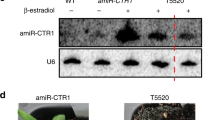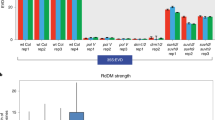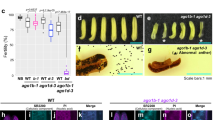Abstract
Argonaute (AGO) proteins recruit 21–24-nucleotide (nt) small RNAs (sRNAs) to constitute RNA-induced silencing complexes (RISCs) to regulate gene expression at transcriptional or posttranscriptional levels1–3. Arabidopsis encodes nine functional AGO proteins. These proteins are classified into three clusters, AGO1/5/10, AGO2/3/7 and AGO4/6/9, based on their sequence similarity, functional redundancy, as well as species and features of AGO-bound sRNAs4–7. Although most Arabidopsis AGO proteins have been studied well, AGO3-bound sRNAs and their basic function remain unknown. Here we observed that AGO3 could not complement the signature function of AGO2, the closest genetic paralog of AGO3, in host antiviral defence. We also found, surprisingly, that AGO3 predominantly bound 24-nt sRNAs with 5′-terminal adenine. The spectrum of AGO3-associated sRNAs was different from those bound to AGO2, further indicating their functional divergence. By contrast, approximately 30% of AGO3-bound 24-nt sRNAs overlapped with those bound to AGO4, and over 60% of AGO3-associated 24-nt sRNA-enriched loci were identical to those of AGO4. Moreover, the redundancy of AGO3- and AGO4-bound sRNAs is much more than that of AGO6- and AGO4-recruited sRNAs. In addition, expression of AGO3 driven by the AGO4 promoter partially complemented AGO4 function and rescued a DNA methylation defect in the ago4-1 background. Together, our results indicated that AGO3, similarly to AGO4, is a component in the epigenetic pathway.
This is a preview of subscription content, access via your institution
Access options
Subscribe to this journal
Receive 12 digital issues and online access to articles
$119.00 per year
only $9.92 per issue
Buy this article
- Purchase on Springer Link
- Instant access to full article PDF
Prices may be subject to local taxes which are calculated during checkout




Similar content being viewed by others
References
Rogers, K. & Chen, X. Biogenesis, turnover, and mode of action of plant microRNAs. Plant Cell 25, 2383–2399 (2013).
Axtell, M. J. Classification and comparison of small RNAs from plants. Annu. Rev. Plant Biol. 64, 137–159 (2013).
Matzke, M. A. & Mosher, R. A. RNA-directed DNA methylation: an epigenetic pathway of increasing complexity. Nat. Rev. Genet. 15, 394–408 (2014).
Mi, S. et al. Sorting of small RNAs into Arabidopsis argonaute complexes is directed by the 5′ terminal nucleotide. Cell 133, 116–127 (2008).
Takeda, A., Iwasaki, S., Watanabe, T., Utsumi, M. & Watanabe, Y. The mechanism selecting the guide strand from small RNA duplexes is different among argonaute proteins. Plant Cell Physiol. 49, 493–500 (2008).
Vaucheret, H. Plant ARGONAUTES. Trends Plant Sci. 13, 350–358 (2008).
Mallory, A. & Vaucheret, H. Form, function, and regulation of ARGONAUTE proteins. Plant Cell 22, 3879–3889 (2010).
Harvey, J. J. et al. An antiviral defense role of AGO2 in plants. PloS ONE 6, e14639 (2011).
Garcia-Ruiz, H. et al. Roles and programming of Arabidopsis ARGONAUTE proteins during Turnip mosaic virus infection. PLoS Pathog. 11, e1004755 (2015).
Jaubert, M., Bhattacharjee, S., Mello, A. F., Perry, K. L. & Moffett, P. ARGONAUTE2 mediates RNA-silencing antiviral defenses against Potato virus X in Arabidopsis. Plant Physiol. 156, 1556–1564 (2011).
Wang, X. B. et al. The 21-nucleotide, but not 22-nucleotide, viral secondary small interfering RNAs direct potent antiviral defense by two cooperative argonautes in Arabidopsis thaliana. Plant Cell 23, 1625–1638 (2011).
Kilian, J. et al. The AtGenExpress global stress expression data set: protocols, evaluation and model data analysis of UV-B light, drought and cold stress responses. Plant J. 50, 347–363 (2007).
Schmid, M. et al. A gene expression map of Arabidopsis thaliana development. Nat. Genet. 37, 501–506 (2005).
Winter, D. et al. An “Electronic Fluorescent Pictograph” browser for exploring and analyzing large-scale biological data sets. PloS ONE 2, e718 (2007).
Wang, H. et al. Deep sequencing of small RNAs specifically associated with Arabidopsis AGO1 and AGO4 uncovers new AGO functions. Plant J. 67, 292–304 (2011).
Hafner, M. et al. Barcoded cDNA library preparation for small RNA profiling by next-generation sequencing. Methods 58, 164–170 (2012).
Hafner, M. et al. Identification of microRNAs and other small regulatory RNAs using cDNA library sequencing. Methods 44, 3–12 (2008).
Zhang, X. et al. Arabidopsis Argonaute 2 regulates innate immunity via miRNA393(*)-mediated silencing of a Golgi-localized SNARE gene, MEMB12. Mol. Cell 42, 356–366 (2011).
Havecker, E. R. et al. The Arabidopsis RNA-Directed DNA methylation argonautes functionally diverge based on their expression and interaction with target loci. Plant Cell 22, 321–334 (2010).
Montgomery, T. A. et al. Specificity of ARGONAUTE7-miR390 interaction and dual functionality in TAS3 trans-acting siRNA formation. Cell 133, 128–141 (2008).
Zhu, H. et al. Arabidopsis Argonaute10 specifically sequesters miR166/165 to regulate shoot apical meristem development. Cell 145, 242–256 (2011).
Cuperus, J. T. et al. Identification of MIR390a precursor processing-defective mutants in Arabidopsis by direct genome sequencing. Proc. Natl. Acad. Sci. 107, 466–471 (2010).
Vaucheret, H., Mallory, A. C. & Bartel, D. P. AGO1 homeostasis entails coexpression of MIR168 and AGO1 and preferential stabilization of miR168 by AGO1. Mol. Cell 22, 129–136 (2006).
Qi, Y. et al. Distinct catalytic and non-catalytic roles of ARGONAUTE4 in RNA-directed DNA methylation. Nature 443, 1008–1012 (2006).
Zilberman, D., Cao, X. & Jacobsen, S. E. ARGONAUTE4 control of locus-specific siRNA accumulation and DNA and histone methylation. Science 299, 716–719 (2003).
Stroud, H., Greenberg, M. V., Feng, S., Bernatavichute, Y. V. & Jacobsen, S. E. Comprehensive analysis of silencing mutants reveals complex regulation of the Arabidopsis methylome. Cell 152, 352–364 (2013).
Pontier, D. et al. NERD, a plant-specific GW protein, defines an additional RNAi-dependent chromatin-based pathway in Arabidopsis. Mol. Cell 48, 121–132 (2012).
Zhang, X. et al. Cucumber mosaic virus-encoded 2b suppressor inhibits Arabidopsis Argonaute1 cleavage activity to counter plant defense. Genes Dev. 20, 3255–3268 (2006).
Zhou, Y. et al. Spatiotemporal sequestration of miR165/166 by Arabidopsis Argonaute10 promotes shoot apical meristem maintenance. Cell Rep. 10, 1819–1827 (2015).
Fujiwara, T., Hirai, M. Y., Chino, M., Komeda, Y. & Naito, S. Effects of sulfur nutrition on expression of the soybean seed storage protein genes in transgenic petunia. Plant Physiol. 99, 263–268 (1992).
Castillo-Gonzalez, C. et al. Geminivirus-encoded TrAP suppressor inhibits the histone methyltransferase SUVH4/KYP to counter host defense. eLife 4, e06671 (2015).
Acknowledgements
We thank L.Y. Zeng for imaging facilities. This work was supported in part by the National Natural Science Foundation of China (NSFC 30725014 and 30621001) to X.-J.W., an National Science Foundation (NSF) grant (NSF CAREER MCB-1253369) and the Welch foundation (A-1777) to X.Z. and a collaborative research grant program NSFC-Texas A&M (02-230204) to X.-J.W. and X.Z.
Author information
Authors and Affiliations
Contributions
Z.Z., X.-J.W. and X.Z. designed the research; Z.Z., X.G. and X.Z. performed the research; X.L. and Z.Z. performed bioinformatics analysis of small RNA libraries and DNA methylation; Z.Z., X.L., X.-J.W. and X.Z. wrote the paper.
Corresponding authors
Ethics declarations
Competing interests
The authors declare no competing financial interests.
Rights and permissions
About this article
Cite this article
Zhang, Z., Liu, X., Guo, X. et al. Arabidopsis AGO3 predominantly recruits 24-nt small RNAs to regulate epigenetic silencing. Nature Plants 2, 16049 (2016). https://doi.org/10.1038/nplants.2016.49
Received:
Accepted:
Published:
DOI: https://doi.org/10.1038/nplants.2016.49
This article is cited by
-
Understanding the evolution of miRNA biogenesis machinery in plants with special focus on rice
Functional & Integrative Genomics (2023)
-
Increased rates of gene-editing events using a simplified RNAi configuration designed to reduce gene silencing
Plant Cell Reports (2022)
-
Unidirectional movement of small RNAs from shoots to roots in interspecific heterografts
Nature Plants (2021)
-
Genome-wide identification, evolutionary relationship and expression analysis of AGO, DCL and RDR family genes in tea
Scientific Reports (2021)
-
Contrasting epigenetic control of transgenes and endogenous genes promotes post-transcriptional transgene silencing in Arabidopsis
Nature Communications (2021)



